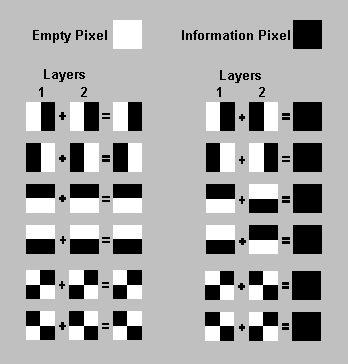How Visual Cryptography works?

Each pixel of the images is divided into smaller blocks. There are always the same number white (transparent) and black blocks. If a pixel is divided into two parts, there are one white and one black block. If the pixel is divided into four equal parts, there are two white and two black blocks. The example images from above uses pixels that are divided into four parts.
In the table on the right we can see that a pixel, divided into four parts, can have six different states.If a pixel on layer 1 has a given state, the pixel on layer 2 may have one of two states: identical or inverted to the pixel of layer 1. If the pixel of layer 2 is identical to layer 1, the overlayed pixel will be half black and half white. Such overlayed pixel is called grey or empty. If the pixels of layer 1 and 2 are inverted or opposite, the overlayed version will be completely black. This is an information pixel.
We can now create the two layers. One transparent image, layer 1, has pixels which all have a random state, one of the six possible states. Layer 2 is identical to layer 1, except for the pixels that should be black (contain information) when overlayed. These pixels have a state that is opposite to the same pixel in layer 1. If both images are overlayed, the areas with identical states will look gray, and the areas with opposite states will be black.
The system of pixel can be applied in different ways. In our example, each pixel is divided into four blocks. However, you can also use pixels, divided into two rectangle blocks, or even divided circles. Also, it doesn't matter if the pixel is divided horizontally or vertically. There are many different pixel systems, some with better contrast, higher resolution or even with color pixels.
If the pixel states of layer 1 are truly (crypto secure) random, both empty and information pixels of layer 2 will also have completely random states. One cannot know if a pixel in layer 2 is used to create a grey or black pixel, since we need the state of that pixel in layer 1 (which is random) to know the overlay result. If all requirements for true randomness are fulfilled, Visual Cryptography offers absolute secrecy according to the Information Theory.
If Visual Cryptography is used for secure communications, the sender will distribute one or more random layers 1 in advance to the receiver. If the sender has a message, he creates a layer 2 for a particular distributed layer 1 and sends it to the receiver. The receiver aligns the two layers and the secret information is revealed, this without the need for an encryption device, a computer or performing calculations by hand. The system is unbreakable, as long as both layers don't fall in the wrong hands. When one of both layers is intercepted it's impossible to retrieve the encrypted information.